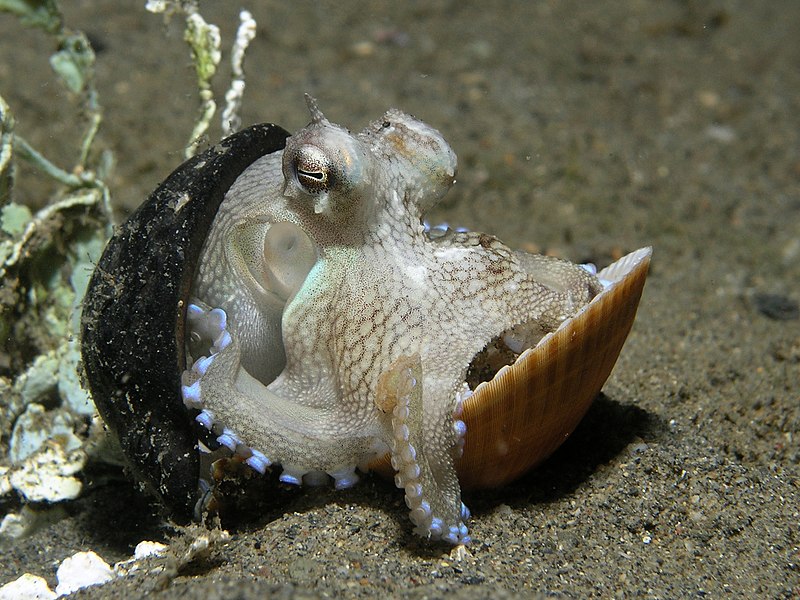The Origins of
Mixed Harvest
Listen to Mixed Harvest Chapter 2 here.
The recently published Mixed Harvest by Rob Swigart is Berghahn’s latest feat of historical fiction, digging into the deep past of human development and its consequences through a combination of storytelling and dialogue. From the first encounter between a Neanderthal woman and a Modern Human she called Traveler to the emergence and destruction of the world’s first cities, Mixed Harvest tells the tale of the Sedentary Divide, the most significant event since modern humans emerged.
Minds
BY ROB SWIGART
Last year I met an alien. It was the size and somewhat shape of a medium-sized frog, with large, bright eyes. It did not move, nor in any way acknowledge my presence.
It belonged to one of three hundred different species of octopus. I don’t know what, or even if it was thinking, nor why. Since it could change its skin color at will, it had decided to be bright lime green.
Now this creature reminds me of the Neanderthals, for both are alien, and both seem in their own ways to be highly intelligent.
Though Neanderthals were closely related to humans, their minds must have been different. Their brains were generally larger (~1,700 vs. ~1,200 cubic centimeters). They had been around for several hundred millennia before we showed up. Their bodies were shaped differently, their diet meatier, and we may presume their social organizations were smaller and more intimate. Describing their lives presents interesting challenges. It’s difficult enough entering the mind of someone from a different culture; speculating with any confidence about a long-departed species, even a cousin, is more difficult by far.
One way is to stretch in by analogy. After all, they were human enough to interbreed with us. We know a bit about their world. We can make educated guesses at the concerns that drove their daily lives, but we can’t truly understand how they thought, how they parsed and navigated their environment, how they faced life and death, how they believed.
But science fiction often explores alien consciousness translated into human terms. Though this risks making aliens simply “Human Lite,” it may not be a bad way to proceed, especially if they are relatable humanoids with prosthetic foreheads (like most of the aliens in Star Trek). They would be driven by the same needs as us Terran primates—fear, power, competition for resources, survival, procreation.
This begs the question, though: we don’t fully understand consciousness itself. Defining it is considered by many to be the hard problem of philosophy. We think we know intuitively: I am me, and I can think about me. But then, who is the I thinking about me, and where in the physical brain does it dwell? Some neuroscientists claim to explain consciousness in purely physical terms: chemistry and physics, neurons, flowing neurotransmitters, triggered hormone flows, and so on. These things do explain much, but not why or how we have experiences like the color red, hunger, love, or anger (what philosophers call qualia). Why we experience these things at all, if they are only there to enhance our fitness for survival. Hunger should simply drive us to eat, the color red to seek out ripe fruit. No need to experience hunger for quiche or a glass of 1961 Château Lafite Rothschild. Fill the belly.
Chemistry and physics somehow fall short.

An intriguing approach to the alien mind is to seek out the most alien one available, and there is no more alien mind on earth than that of the cephalopod—squid, cuttlefish, octopus, and the slow, majestic, enigmatic nautilus. They are science fiction’s monstrous aliens with the benefit of actually existing.
The octopus in particular has captured public imagination because, well, they are darned cute. But, boy, are they alien! Eight arms, each with its own semi-autonomous brain and myriad powerful suckers, a ninth brain behind the eyes. The digestive system runs through the middle of that brain. Three hearts pump blue blood. Skin that can change color and pattern to match the background while the eyes look the other way, which means chromatophores in the skin are doing the seeing. Taste buds in its suckers. Strange, and quite varied, mating machinery. Short life span (for most, one or two years). Solitary. A single tremendous reproductive explosion at the end of life.
Yet these writhing, complicated bodies can innovate, solve problems, make tools, rearrange their environment by building structures, or adapting found objects like coconut shells into moving shelters. They can quickly figure out how to open screw-top bottles and have been known to escape from a lab tank, across the floor, down a drain to the sea, all without the benefit of tradition or learning (no bones!) They can squeeze through an opening only a tiny bit larger than their beak, the only hard substance in the body—say the size of a quarter. They appear to dream and make eye contact with humans, yet they are cold blooded cannibals. And of course, they live under water, sometimes very far under water, yet can sometimes clamber over dry land to hunt.
What would it be like to have eyes that look over a cluster of independently guided arms surrounding a parrot beak that can shred living prey and push it into a gullet surrounded by a brain that makes decisions about what color to be at any given time?
Just grasping a sense of a world perceived mostly through taste and texture while signaling others of your kind by changing skin patterns like an advertising LCD screen is as intriguing as it is perplexing. Cephalopods may be of earth, but they are ancient and other. They definitely know things we don’t.
For the emergence, evolution, and history of cephalopods, (they were here long before we appeared), the best introduction is Squid Empire: The Rise and Fall of the Cephalopods, by Danna Staaf (ForeEdge, 2017). Staaf also authors the blog, The Cephalopodiatrist. For a more philosophical exploration of their strange form of intelligence, Peter Godfrey-Smith’s Other Minds: The Octopus, the Sea, and the Evolution of Consciousness, (Farrar, 2016) can’t be surpassed. Both are entertaining and stimulating introductions to our chilly, blue-blooded neighbors and why they are important reminders that our dominance is nothing special and won’t last forever.
ABOUT THE AUTHOR
ROB SWIGART has a doctorate in comparative literature. Since then he’s worked as a technical writer, computer journalist, designer and scriptwriter for computer games. With Portal for Activision, he pioneered computer narrative and later served as secretary of the board of the Electronic Literature Organization. For a dozen years, he was a Research Affiliate at the Institute for the Future.
Because of his lifelong interest in the deep past, he described this work as a kind of future archaeology. In the first decade of the 21st century, he turned his attention full-time to archaeology and wrote two textbook-novels, Xibalba Gate: A Novel of the Ancient Maya and Stone Mirror: A Novel of the Neolithic, while a visiting scholar at the Stanford Archaeology Center. His new novel Mixed Harvest is a collection of short fiction that chronicles mankind’s mistaken adoption of agriculture.
Listen to Swigart’s reading of “Bringer,” Chapter 2 of Mixed Harvest here.
Read more from Rob Swigart’s Origins of Mixed Harvest series:
“Climate”
“Context”

